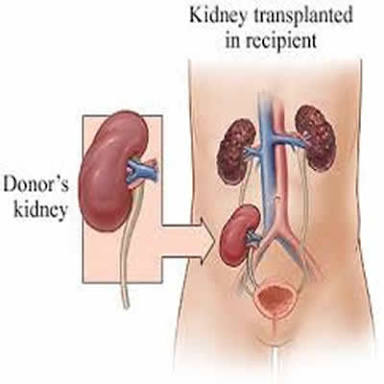Kidney Transplantation
Kidney transplantation or renal transplantation is the transplant of a kidney into a patient with end-stage renal disease. Kidney transplantation is typically classified as deceased-donor (formerly known as cadaveric) or living-donor transplantation depending on the source of the donor organ. Living-donor renal transplants are further characterised as genetically related (living-related) or non-related (living-unrelated) transplants, depending on whether a biological relationship exists between the donor and recipient.
A person receiving a transplant usually receives only one kidney, but, in rare situations, he or she may receive two kidneys from a deceased donor. In most cases, the diseased kidneys are left in place during the transplant procedure. The transplanted kidney is implanted in the lower abdomen on the front side of the body.
The following steps will precede the transplant:
- – Your physician will explain the procedure to you and offer you the opportunity to ask any questions that you might have about the procedure.
- – You will be asked to sign a consent form that gives your permission to do the surgery. Read the form carefully and ask questions if something is not clear.
- – If you have been on routine dialysis before the procedure, you will receive dialysis prior to the procedure.
- – For a planned living transplant, you should fast for eight hours before the operation, generally after midnight. In the case of a cadaver organ transplant, you should begin to fast once you are notified that a kidney has become available.
- – You may receive a sedative prior to the procedure to help you relax.
- – Based upon your medical condition, your physician may request other specific preparation.
AV FISTUAL SURGERY
An arteriovenous fistula (AV fistula) is the connection of a vein and an artery, usually in the forearm, to allow access to the vascular system for hemodialysis, a procedure that performs the functions of the kidneys in people whose kidneys have failed. Connecting the vein and artery is a surgical procedure. The fistula develops over a period of months after the surgery.
The surgical creation of an AV fistula provides a long-lasting site through which blood can be removed and returned during hemodialysis. The fistula, which allows the person to be connected to a dialysis machine, must be prepared by a surgeon weeks or months before dialysis is started. When the vein and artery are joined, the vein gradually becomes larger and stronger, creating the fistula that provides vascular access years longer than other types of access and with fewer complications.
Sometimes dialysis is only needed temporarily, but some people need it for the rest of their lives or until a kidney is available for a transplant. When kidney failure is diagnosed, time is needed to prepare the patient’s body with either an AV fistula or implantable devices that will connect the person to the dialysis machine.

Primary pages
Contact us
Name : Dr. Amit Kumar Jha
Phone : 992 952 3110
Email : amitkumarjha2252@gmail.com
Address : OPD number 137, first floor, Bansal hospital, C sector Shahpura, Bhopal, Madhya Pradesh. India. PIN – 462016